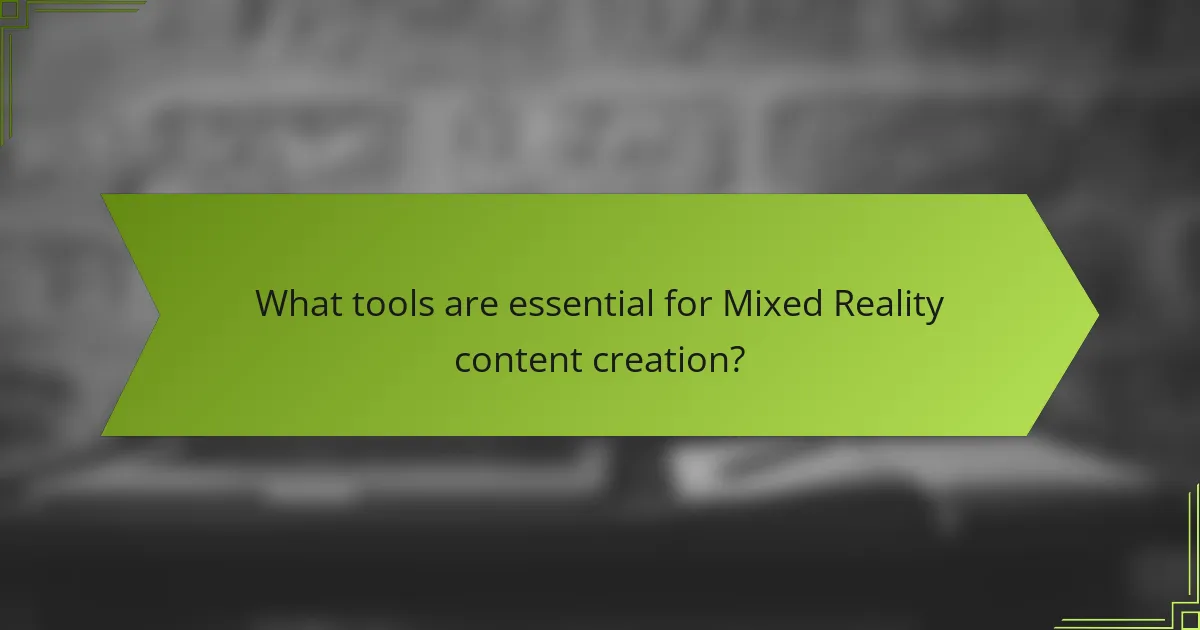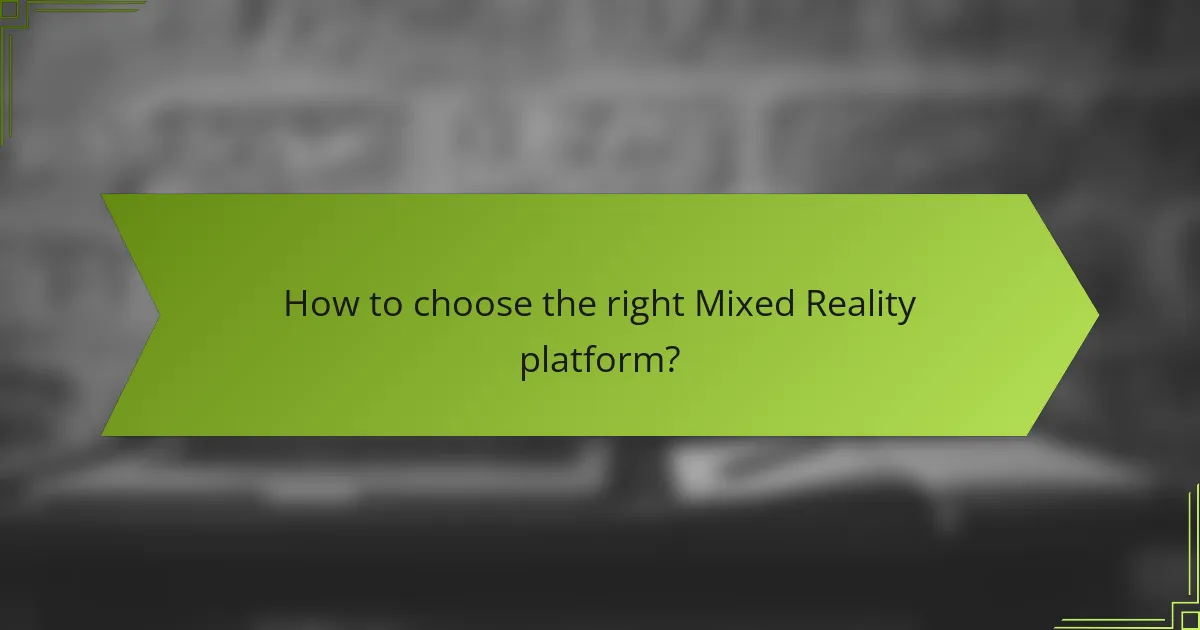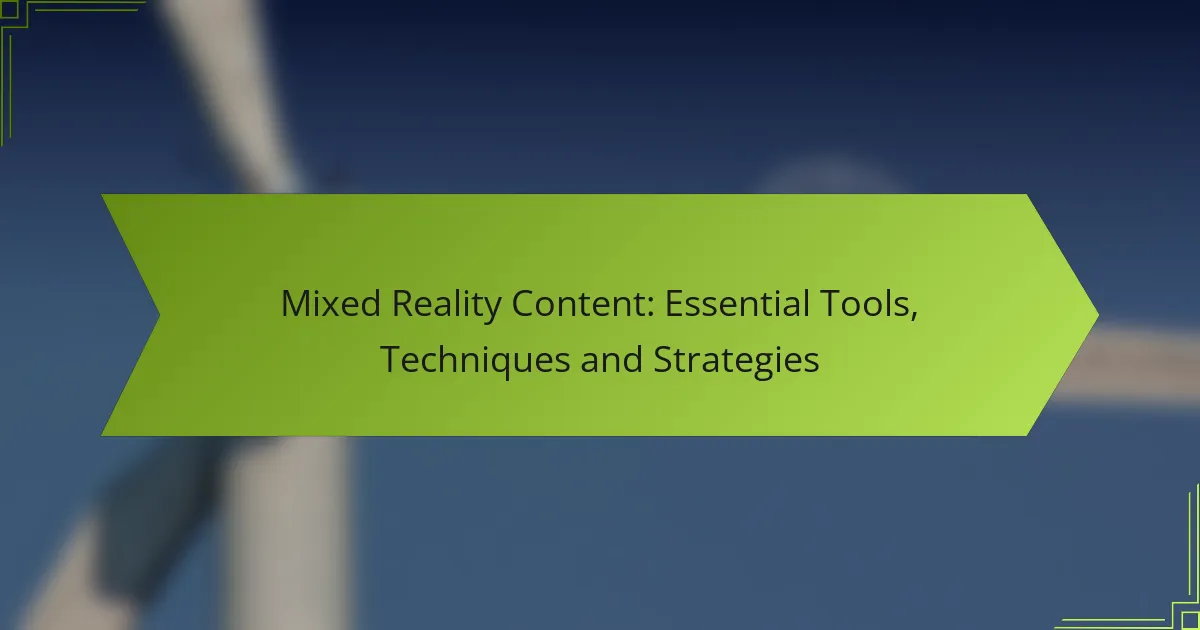Mixed Reality (MR) content creation requires a blend of essential tools and techniques to craft immersive experiences. Key software and hardware, such as Unity, HoloLens, and Oculus Quest, are vital for development, while effective storytelling techniques like interactive narratives and spatial audio enhance user engagement. Selecting the right MR platform is crucial, as it impacts user experience and project compatibility.

What tools are essential for Mixed Reality content creation?
Essential tools for Mixed Reality (MR) content creation include software and hardware that facilitate development, design, and immersive experiences. Key tools like Unity, HoloLens, Oculus Quest, Adobe Aero, and Blender play significant roles in the MR ecosystem.
Unity for development
Unity is a leading game engine widely used for developing Mixed Reality applications. It supports both 2D and 3D content and offers a robust set of features for creating interactive experiences.
When using Unity, consider leveraging its extensive asset store and community resources. Familiarize yourself with the MR Toolkit, which provides pre-built components to streamline development.
Microsoft HoloLens for hardware
The Microsoft HoloLens is a mixed reality headset that blends digital content with the real world. It features advanced sensors and spatial mapping capabilities, allowing for immersive experiences that respond to the user’s environment.
When working with HoloLens, focus on optimizing your applications for performance and user experience. Ensure that your content is designed to take advantage of the device’s unique features, such as hand tracking and voice commands.
Oculus Quest for immersive experiences
The Oculus Quest is a standalone virtual reality headset that provides an immersive experience suitable for Mixed Reality applications. Its wireless capabilities and intuitive controls make it accessible for a wide range of users.
To maximize the potential of Oculus Quest, consider developing applications that utilize its room-scale tracking. This allows users to interact with virtual objects in a more natural and engaging way.
Adobe Aero for design
Adobe Aero is a powerful tool for creating augmented reality experiences without extensive coding knowledge. It allows designers to build interactive content quickly using a visual interface.
When using Adobe Aero, focus on integrating 3D models and animations to enhance your designs. Take advantage of its compatibility with other Adobe products to streamline your workflow and maintain design consistency.
Blender for 3D modeling
Blender is an open-source 3D modeling software that is widely used for creating assets for Mixed Reality applications. It offers a comprehensive suite of modeling, animation, and rendering tools.
To effectively use Blender, familiarize yourself with its interface and shortcuts to speed up your workflow. Consider exporting your models in formats compatible with Unity or other MR platforms to ensure seamless integration.

How to choose the right Mixed Reality platform?
Choosing the right Mixed Reality platform involves evaluating user experience, device compatibility, and community support. These factors will help ensure that the platform meets your project’s needs and provides a seamless experience for users.
Evaluate user experience
User experience is crucial when selecting a Mixed Reality platform. Look for platforms that offer intuitive interfaces, engaging content, and smooth interactions. A positive user experience can significantly enhance user retention and satisfaction.
Consider conducting user testing with prototypes on different platforms to gather feedback. This will help identify which platform provides the most enjoyable and effective experience for your target audience.
Consider compatibility with devices
Device compatibility is essential for ensuring that your Mixed Reality content reaches the widest audience. Check if the platform supports various devices, such as smartphones, tablets, and dedicated headsets like Oculus or HoloLens.
It’s also important to consider the operating systems and hardware requirements. A platform that works across multiple devices and systems can save time and resources during development.
Assess development community support
A strong development community can greatly enhance your experience with a Mixed Reality platform. Look for platforms that have active forums, tutorials, and resources available to assist developers.
Platforms with robust community support often provide better documentation and troubleshooting assistance, which can accelerate your development process. Engaging with the community can also lead to valuable networking opportunities and collaboration on projects.

What techniques enhance Mixed Reality storytelling?
Techniques that enhance Mixed Reality storytelling include interactive narratives, spatial audio integration, and real-time user feedback. These elements create immersive experiences that engage users and deepen their connection to the story.
Interactive narratives
Interactive narratives allow users to influence the storyline through their choices, creating a personalized experience. This technique can be implemented using branching storylines where decisions lead to different outcomes, enhancing engagement and replayability.
To effectively design interactive narratives, consider user motivations and the impact of choices on the overall story. Use clear visual cues and feedback to guide users through their decisions, ensuring they feel their input matters.
Spatial audio integration
Spatial audio integration enhances the storytelling experience by providing sound that corresponds to the user’s location and movement within the Mixed Reality environment. This technique helps create a more immersive atmosphere, making users feel as though they are part of the story.
When implementing spatial audio, ensure that sounds are positioned accurately in 3D space. Use high-quality audio assets and consider the acoustic properties of the environment to enhance realism. Testing with users can help fine-tune audio placement for maximum impact.
Real-time user feedback
Real-time user feedback allows creators to adapt the experience based on user actions and preferences. This technique can include visual indicators, haptic responses, or even narrative adjustments that respond to user behavior.
To effectively incorporate real-time feedback, establish clear metrics for user interactions and design systems that can respond dynamically. Avoid overwhelming users with too much information at once; instead, provide subtle cues that guide them without disrupting the flow of the story.

What are the best practices for Mixed Reality design?
The best practices for Mixed Reality (MR) design focus on creating immersive, intuitive experiences that prioritize user engagement and accessibility. By employing user-centered design principles, utilizing effective prototyping tools, and incorporating accessibility features, designers can enhance the overall effectiveness and reach of their MR applications.
Focus on user-centered design
User-centered design is essential in Mixed Reality to ensure that experiences are tailored to the needs and preferences of the target audience. This approach involves understanding user behaviors, motivations, and contexts through research methods such as interviews and usability testing.
Designers should create personas and scenarios that represent their users, allowing for more relatable and relevant design decisions. Regular feedback loops during the design process can help identify pain points and improve usability, leading to a more engaging experience.
Utilize prototyping tools
Prototyping tools are crucial for visualizing and testing Mixed Reality concepts before full-scale development. Tools like Unity, Unreal Engine, and SketchUp allow designers to create interactive prototypes that simulate user interactions and environments.
Using these tools, designers can iterate quickly, making adjustments based on user feedback and technical feasibility. This iterative process helps to refine the design and ensures that the final product meets user expectations and technical requirements.
Incorporate accessibility features
Incorporating accessibility features in Mixed Reality design is vital to ensure that all users, including those with disabilities, can fully engage with the content. This includes providing options for voice commands, customizable controls, and visual aids that enhance navigation.
Designers should follow established accessibility guidelines, such as the Web Content Accessibility Guidelines (WCAG), to create inclusive experiences. Testing with diverse user groups can also highlight areas for improvement and ensure that the application is usable for everyone.

How to measure the success of Mixed Reality content?
Measuring the success of Mixed Reality content involves evaluating user engagement, gathering feedback, and utilizing analytics tools. These metrics provide insights into how well the content resonates with users and its overall effectiveness in achieving intended goals.
User engagement metrics
User engagement metrics are crucial for assessing how audiences interact with Mixed Reality content. Key indicators include session duration, interaction rates, and repeat visits. For example, a session duration of several minutes can indicate strong engagement, while low interaction rates may suggest content needs improvement.
Consider tracking metrics like the number of unique users and the frequency of user interactions within the experience. High engagement often correlates with user satisfaction and content effectiveness.
Feedback and reviews
Collecting feedback and reviews is essential for understanding user perceptions of Mixed Reality content. Direct user comments can highlight strengths and weaknesses, guiding future improvements. Encourage users to leave reviews on platforms where the content is hosted, as this can provide valuable qualitative data.
Implementing surveys or feedback forms immediately after the experience can yield actionable insights. Aim for specific questions that address user satisfaction, ease of use, and overall enjoyment to gather focused feedback.
Analytics tools like Google Analytics
Analytics tools, such as Google Analytics, are vital for tracking user behavior and performance metrics of Mixed Reality content. These tools can provide data on user demographics, traffic sources, and engagement patterns, helping to identify which aspects of the content are most effective.
Set up event tracking to monitor specific interactions within the Mixed Reality experience, such as button clicks or navigation paths. This data can reveal how users navigate through the content and where they may encounter difficulties, allowing for targeted enhancements.

What are the emerging trends in Mixed Reality?
Emerging trends in Mixed Reality (MR) include advancements in hardware, enhanced user experiences, and increased integration with artificial intelligence. These developments are shaping how users interact with digital content in real-world environments, making MR more accessible and engaging.
Advancements in Hardware
Recent advancements in hardware have significantly improved the Mixed Reality experience. Devices like Microsoft HoloLens 2 and Magic Leap 2 offer higher resolution displays, better field of view, and improved tracking capabilities. These enhancements allow for more immersive and realistic interactions with virtual objects.
Additionally, the introduction of lightweight, portable headsets is making MR technology more user-friendly. This shift is crucial for applications in industries such as healthcare, education, and entertainment, where ease of use can enhance training and engagement.
Enhanced User Experiences
Enhanced user experiences in Mixed Reality focus on creating intuitive and engaging interactions. This includes the use of natural gestures, voice commands, and haptic feedback, which allow users to interact with digital content seamlessly. For example, users can manipulate 3D models in real-time, making learning and collaboration more effective.
Moreover, the integration of social features in MR applications is fostering collaboration among users. This trend is particularly evident in remote work scenarios, where teams can meet in virtual spaces to brainstorm and share ideas, improving productivity.
Increased Integration with Artificial Intelligence
The integration of artificial intelligence (AI) into Mixed Reality applications is driving personalized experiences and smarter interactions. AI can analyze user behavior and preferences, allowing MR systems to adapt content dynamically. For instance, AI-driven analytics can provide insights into how users engage with virtual environments, leading to more tailored experiences.
Furthermore, AI enhances object recognition and tracking capabilities, making it easier for MR systems to identify and interact with real-world objects. This capability is particularly beneficial in retail and training environments, where accurate recognition can streamline processes and improve outcomes.
